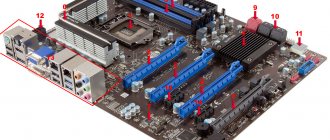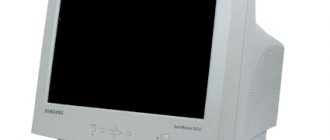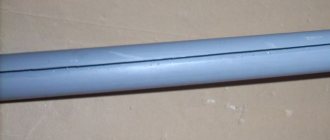Although the spelling of LED is similar to OLED, it means a completely different technology for constructing a screen. What does liquid crystal LED TV mean? This is a TV with an LCD matrix and LED backlighting.
And if OLED (Organic Light-Emitting Diode) means that the screen consists of organic light-emitting diodes, then LED (Light Emitting Diode) is the use of diodes to illuminate the matrix of a liquid crystal television receiver.
LED (Light Emitting Diode) is a light-emitting diode, and in television technology this abbreviation means a screen on a liquid crystal matrix (LCD) and backlit by these light-emitting diodes. After the introduction of a new type of backlight, TV manufacturers began to replace “LCD” with “LED” in model names.
This was done more from a marketing point of view. In fact, it was not a new screen technology, just a different type of backlight. But this name for televisions has been preserved and is used today.
As you know, LCD screens on TVs consist of cells (pixels) with liquid crystals and, depending on the position of the crystal in the cell, transmits light or not. This creates a glow on the screen.
The quality of the LCD matrix determines such parameters as static contrast, black level, viewing angles, refresh rate, response time. There are such technologies for producing liquid crystal matrices for TVs: TN, IPS (S-IPS, IPS-Pro, P-IPS, AH-IPS), VA/MVA/PVA, PLS.
Today, TN matrices have left the market due to their very low color rendering quality; they are used for PC monitors.
IPS and VA matrices with their own varieties have received development. A new ADS matrix has also appeared.
Parameters such as brightness, color rendering, color gamut, and dynamic contrast depend on the backlight. Although it is more correct to consider the matrix + backlight system in the TV and measure the parameters for it.
Manufacturers claim that the use of LED backlighting can increase:
- brightness,
- image clarity,
- color scheme.
The energy consumption of LED TVs is also reduced by about 40%. Also, ice TVs do not use mercury, which is used in fluorescent lamps, which affects the environment.
Indeed, modern ultra-bright LEDs can provide high brightness of the image on the display.
The contrast increases and the concept of dynamic contrast is introduced, when the brightness of the LEDs is adjusted locally for different areas of the screen, and due to this the dynamic contrast indicator increases. At the same time, the level of static contrast of the TV remains the same, it depends on the display matrix.
The black level is also improved by adjusting the glow of the diodes while watching a video. In a dark scene, the backlight level decreases and the screen becomes darker, and hence the black level improves.
But as for increasing the color gamut of the TV, we need to consider everything in more detail.
Information about color gamut and color gamut.
LED TV: features
An LED TV is a thin TV with a liquid crystal display, which differs from other models in a certain type of backlight, which uses LEDs to transmit images. This system is called Light Emitting Diode (LED).
LED TVs differ from other models in that they have become visually thinner and safer, since they no longer use mercury in their production. The quality of the picture has increased significantly, the depth and saturation of colors, as well as detail, have appeared.
LED connection.
The simplest way to connect an LED is to connect it with a resistor. The latter is necessary for current limiting to prevent LED burnout during voltage surges.
When connecting LED elements according to any scheme, do not forget to maintain polarity! Otherwise, the semiconductor device will not glow and will burn out.
Electrical diagram for connecting an LED (LED) and a resistor (R).
When connecting several light-emitting diodes, different options for connecting them are possible.
Serial connection.
Serial connection diagram.
The elements are connected in series, taking into account polarity. In the circuit, the current value is constant, and the voltage across the LED elements is summed up.
Parallel connection.
Diagram of parallel connection of LEDs through one resistor.
In this case, the voltage in the circuit remains constant, and the currents on the elements add up. This type of connection has a disadvantage. Different LEDs may have different voltage drops. Therefore, the current on any element may exceed the permissible value, which will lead to breakdown.
To avoid this, you should connect a different resistor to each parallel circuit.
Parallel connection diagram.
Parallel-serial connection.
When connecting a large number of LEDs, it is worth using a parallel-series electrical circuit. At the same time, the voltage in parallel branches is the same.
Electrical diagram of parallel-series connection.
How does LED work?
Previously, TVs used fluorescent lamps, which produced lower brightness, dull colors and grainy pictures. LED TVs operate using LEDs, which allows them to achieve increased brightness and good luminosity.
The very principle of operation of LEDs is based on highlighting certain areas that the picture requires. If there are dark places in the picture, the LEDs turn off or “go out,” which ultimately saves a sufficient amount of energy. It is LED technology that provides rich, deep black color, which analogue TVs could not previously provide.
The advantages of LED backlighting include the following:
- The thin body of the TV is due to LED backlighting, where each diode is no more than 5 mm in size, in contrast to more outdated fluorescent lamps - 10 mm.
- Picture quality – brightness, black color saturation and detail increase. LEDs can turn off at the right moment in the picture, which significantly enhances contrast and increases the richness of all colors.
- Energy saving up to 40%
- Additional features – LED TVs provide access to various additional features in the form of Skype conversations and quick “surfing” on the Internet.
LED manufacturers
Installation of LEDs.
Several world-famous companies are in the lead in the ranking of manufacturers. They produce the highest quality products on the market.
- Philips. Perhaps the manufacturer with the most famous name. This brand produces many products from light bulbs to telephones. The company has factories in more than sixty countries. Actively invests in the latest developments. Buys other, smaller factories and production facilities that produce LEDs.
- Cree. An American company that began its journey with the production of chips for phones. Specializes in the production of LED products for various purposes. RPa has developed and produces LEDs made of silicon carbide that shine brightly.
- Nichia. Japanese company. One of the oldest in the field of LED technology manufacturing. It was she who developed and introduced the production of blue and white LED colors. Specializes in the production of crystals. Market leader in terms of sales revenue.
- Osram. German manufacturer. It has been working in tandem with Siemens for over a hundred years. It produces light-emitting diodes that meet international quality standards.
Among Russian manufacturers, you can also find Svetlana-Optoelectronics. Both companies are located in St. Petersburg and produce lighting products. However, crystals for production are purchased abroad.
Methods (types) of LED backlighting
There are two types of LED backlighting:
- White (WLED)
– white light-emitting LED. - Three-color (RGB)
- the use of LEDs in three primary colors: red, green and blue.
Differences in design and layout of LEDs:
- Edge LED
is an edge or side circuit, where LEDs can be located along the edge of the matrix (perimeter) and turn on alternately, depending on the transmitted picture. This is a cheaper type of LED design, due to the reduction in the number of diodes, which also affects the thickness of the TV, which becomes much thinner. - Direct LED
- a matrix arrangement of LEDs distributes them across the entire screen and this is what makes it possible to regulate the selective switching off of the diodes in the place of the picture where there should be dimming. The contrast of the picture increases by several points, the richness of colors and the depth of black increase. The Direct LED circuit will cost an order of magnitude more than the one described above.
Diode arrangement diagram Difference in image quality according to diagrams
History of LED creation.
It dates back just over a hundred years. The first mention of the glow of a diode dates back to 1907 . English physicist Henry Round noticed multi-colored radiation when electricity flowed through silicon carbide-metal compounds. This phenomenon is called electroluminescence.
Almost twenty years later, in 1923 , Russian scientist Oleg Losev conducted similar experiments in Nizhny Novgorod. The physicist discovered a glow at the point of contact between silicon carbide and steel wire. Losev published the results of his research and substantiated that electroluminescence is observed precisely at the boundary of contact of dissimilar materials. They could not provide a theoretical basis for the discovery, and it did not receive further development. Although Losev predicted the use of electroluminescence to create low-power and miniature light sources. The physicist even came up with the design of a light relay, but the research did not continue.
In 1961, another forty years later, American inventors D. R. Bayard and G. Pittman came up with a technology for producing LEDs from gallium arsenide. In 1962, they received a patent and industrial production began. However, their LED element emitted infrared radiation, that is, it was not visible to the human eye.
But in the same 1962, American physicist Nick Holonyak invented the red LED. In 1971, his compatriot Jacques Pankow invented blue. And in 1972, George Craford discovered the yellow LED.
However, until the seventies of the 20th century, light-emitting diodes remained very expensive. was the first in the world to organize mass production of LED as an indicator.
In the seventies, a group of Soviet scientists under the leadership of Zh. Alferov managed to synthesize previously unknown semiconductor substances. They began to be produced at enterprises and laboratories. And based on these connections, serial production of LEDs was launched.
In 1983, Citizen Electronics invented and introduced flat panel design (SMD) LEDs into its facilities.
In the nineties, Japanese scientists I. Akasaki, H. Amano and S. Nakamura figured out how to significantly reduce the cost of producing blue LEDs. The technology has been successfully tested by Nichia since 1993. And since 1996, they began producing white LED elements, whose light is obtained from a combination of red, blue and green. Subsequently, based on the discovery of Japanese scientists, new methods for the production of lighting equipment began to rapidly develop: light bulbs, backlit displays and other devices.
In 2003, Citizen Electronics came up with the latest COB (Chip-On-Board) technology. It involves mounting a semiconductor element onto a substrate using a special non-conductive adhesive.
It is obvious that the history of light-emitting diodes is only gaining momentum, and the technologies are becoming more advanced.
It took a long time to create the different colors.
Examples of popular LED TV models
We have presented some of the best LED TV models below with a description of the characteristics and main advantages:
Thomson T32RTL5130
The high-quality assembly of the LED model and its affordable price have brought the TV to the forefront in popularity. The screen coating is glossy, which enhances the richness of colors and the overall brightness of the image.
Key Features
- Diagonal - 32 inches
- Resolution - 1366*768
- Matrix frequency - 50/100 Hz
- Sound power - 10 W
- 3D mode
Best deals
LG 43LM6500
The very colorful and bright TV display is equipped with a glossy anti-glare coating. Despite the low frequency indicators, image improvement is achieved using a 4-core graphics processor.
Key Features
- Diagonal - 42.5 inches
- Resolution - 1920*1080
- Matrix frequency - 60 Hz
- Sound power - 20 W
- Artificial intelligence support; voice control.
Best deals
Samsung UE49NU7300U
The model is equipped with a modern curved screen, which makes it possible to enjoy the picture without boundaries. The advantages include the Tizen platform type, HDR10 support, and the ability to record and stop video.
Key Features
- Diagonal - 48.5 inches
- Resolution – 3840*2160 4K
- Matrix frequency - 60/120 Hz
- Sound power - 20 W
- Curved screen
Best deals
Philips 50PUT6023
Ultra-thin LED TV with a glossy screen, which is additionally equipped with an anti-glare coating. The Pixel Plus Ultra HD processor is responsible for image enhancement.
Key Features
- Diagonal - 50 inches
- Resolution – 3840*2160 4K
- Matrix frequency - 60/80 Hz
- Sound power - 16 W
- Recording TV programs
Best deals











